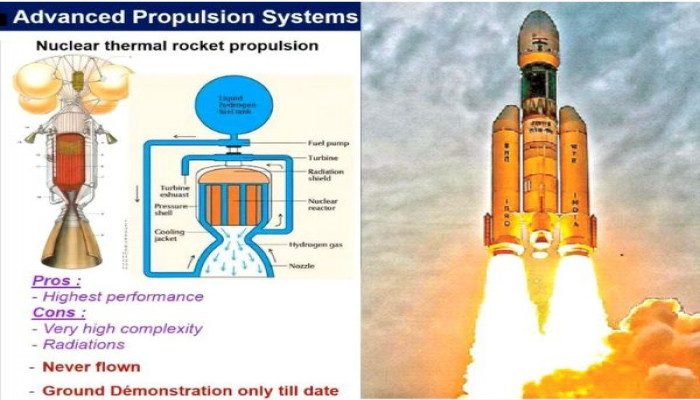ISRO conducts successful trials of Advanced Nuclear Thermal Propulsion System
- In Reports
- 09:20 PM, Feb 22, 2025
- Myind Staff
The Indian Space Research Organisation (ISRO) has commenced trials for nuclear-powered propulsion systems, marking a major step forward in space exploration. This advancement aims to enhance the efficiency and speed of interplanetary missions, overcoming challenges faced by traditional propulsion methods. The use of nuclear technology in space travel could revolutionise long-duration missions, making destinations like Mars more accessible in shorter timeframes.
Conventional space propulsion relies on either chemical fuel or solar energy. Solar-powered systems are effective within the inner Solar System but become less viable as spacecraft travel farther from the Sun. Missions like Chandrayaan-3 have demonstrated these limitations, where reduced sunlight restricted the lander’s operational duration.
Chemical propulsion also has drawbacks, primarily its reliance on oxidisers like oxygen, which are scarce in space. Additionally, chemical rockets require six to nine months to reach Mars, increasing astronauts’ exposure to cosmic radiation and microgravity-related health risks.
Nuclear Thermal Propulsion (NTP) offers a more efficient alternative. By utilising nuclear fission, these engines can generate significantly higher thrust, enabling a trip to Mars in approximately 45 days—far shorter than conventional methods.
NTP provides nearly five times the efficiency of chemical rockets, allowing for increased payload capacity and longer mission durations. The consistent energy output of nuclear power also makes it suitable for deep-space missions beyond the Solar System.
ISRO has successfully tested an atomic-powered engine’s first stage, specifically a radioisotope heating unit (RHU), on Chandrayaan-3’s propulsion module, which remains in lunar orbit. The RHU generates heat through the radioactive decay of isotopes, typically plutonium-238. This technology provides continuous thermal energy, ensuring that critical spacecraft systems remain functional even in extreme cold.
Each RHU produces approximately one watt of heat, a small yet vital amount for maintaining operational temperatures. Chandrayaan-3's propulsion module included two RHUs, which helped preserve system functionality. Unlike Radioisotope Thermoelectric Generators (RTGs), which convert radioactive decay into electricity for missions like Voyager and Cassini, RHUs strictly provide heat. The success of RHUs in Chandrayaan-3 marks a critical milestone in ISRO’s efforts to integrate nuclear power into future missions.
ISRO is working closely with the Bhabha Atomic Research Centre (BARC) to develop advanced nuclear power systems. A key focus is the creation of a 100-watt RTG, a vital component for powering nuclear propulsion technology.
RTGs convert heat from radioactive decay into electrical energy, ensuring long-lasting and reliable power for spacecraft systems such as communication, navigation, and scientific instruments.
RTGs provide numerous advantages over traditional chemical batteries, offering sustained power for extended missions without requiring refuelling or maintenance. BARC, as India’s premier nuclear research institution, contributes expertise in radioactive material handling, nuclear safety, and waste management. The organisation also possesses critical infrastructure, such as the Apsara-U reactor, which aids in the indigenous production of necessary radioisotopes for RTGs.
Nuclear thermal rockets operate by using a fission reactor to heat liquid propellants, significantly increasing efficiency over chemical propulsion. ISRO’s planned use of this technology for future interplanetary missions promises faster transit times and improved mission capabilities.
Key components of the nuclear rocket, including the start-up system, control valve, control rod, cooling channel, thrust chamber, program controller and fuel pump, have been successfully developed. A launch is expected soon, positioning India among the leading nations in nuclear-powered space exploration.
However, nuclear propulsion introduces safety concerns, particularly regarding potential launch accidents and radioactive waste disposal. ISRO and BARC are addressing these challenges through stringent safety protocols and waste management strategies to ensure secure deployment and long-term sustainability.
India's advancements in nuclear propulsion technology mark a transformative moment in space exploration. By integrating nuclear power, ISRO can overcome the limitations of traditional propulsion, enabling faster, more efficient missions to Mars and beyond.
Former ISRO Chairman S. Somanath has emphasised the vital role of India's nuclear sector in shaping future space endeavours, aligning with global efforts to harness nuclear energy for space travel. With continued innovation and collaboration, ISRO’s nuclear propulsion program holds immense potential for shaping the future of deep-space exploration.







Comments